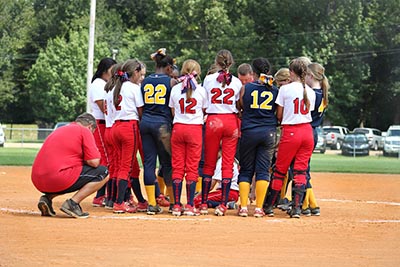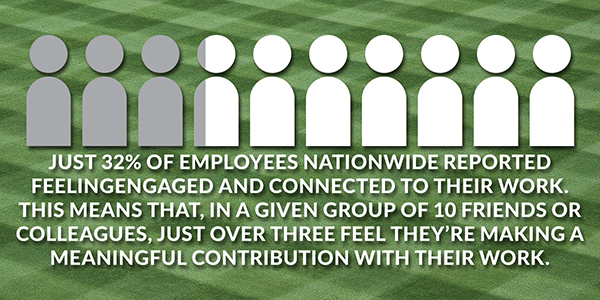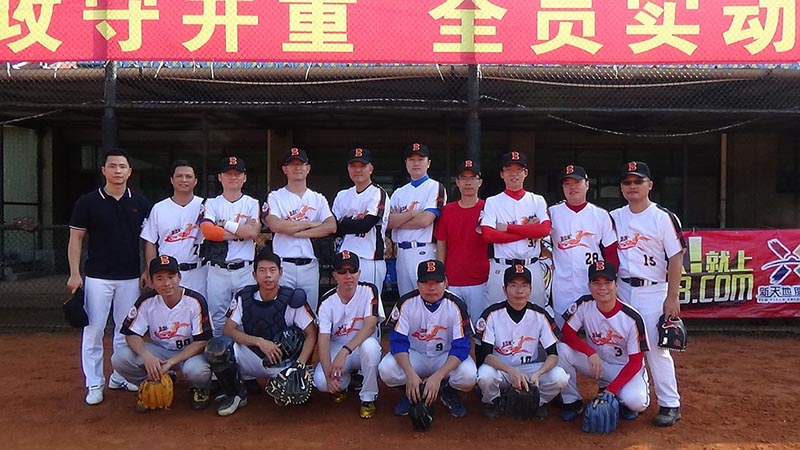How to Start a Softball League Together

 From the youngest of athletes to seniors hoping to stay active, one immovable fact spans the life cycle—things are more fun when you get a free t-shirt. Road races, volunteer opportunities, team sports—you name it, the t-shirt makes it. Softball leagues are no exception. The uniform, however informal, inspires a sense of unity, pride in athletic ability, and serves as a beacon to all: “I’ve earned free pizza after the game I’ve played.”
From the youngest of athletes to seniors hoping to stay active, one immovable fact spans the life cycle—things are more fun when you get a free t-shirt. Road races, volunteer opportunities, team sports—you name it, the t-shirt makes it. Softball leagues are no exception. The uniform, however informal, inspires a sense of unity, pride in athletic ability, and serves as a beacon to all: “I’ve earned free pizza after the game I’ve played.”
If you’re hoping to create this opportunity for bonding and athleticism for others, there are a great many things you’ll need to know before getting started. But, fear not: we’ve collected our best tips for getting your league off the ground. Trust us. T-shirts are only the beginning.

Benefits of Starting a Softball League
Few Americans, whether they are knowledge workers or physical laborers, would tell you they have an abundance of free time. Life is busy, full to the brim with obligations and activities, and adding a commitment to a softball league might seem like one more thing added to their long to-do lists. As you seek to recruit interested players, which is the first big hurdle in creating a successful league, you’ll want to be able to share what their time and energy will give them in the long run. Here are a few suggestions for ways to “sell” friends and colleagues on this grand experiment.

Morale
The Gallup organization reported in 2016 that just 32% of employees nationwide reported feeling engaged and connected to their work in their polling data from the prior year. This means that, in a given group of 10 friends or colleagues, just over three feel they’re making a meaningful contribution with their work. With as much time as we spend in the office, that’s a sad statistic. While some may seek to combat this feeling of disengagement by switching jobs or even career paths, others might seek to find diversions in their non-working hours that help their lives feel rewarding. A softball league could create such an environment.

Especially if the imagined league is one designed to bring colleagues together (either in one organization or across an industry), these out-of-office opportunities help players show sides of one another that may not present themselves at work. Further, the orientation toward a common goal can help players cultivate a team mindset and uncover hidden skills and talents—hidden, perhaps, even from the individual themselves! Tap into this skill discovery by letting members pick official post-game hangouts, or design team shirts or even some of the more contentious rules.

Healthy Competition
While competition sometimes has an outlet in the workplace, it tends to be looked down upon there. Most of us really only see the competitive nature at work when it evolves into a hyper-competitive spirit, more closely resembling ruthlessness. This type of competitive nature can be toxic in large doses, no matter where it arises. By providing an outlet where a competitive spirit is valued and even necessary, team members can channel that “get ahead” energy into a new endeavor.

Exercise
For those seeking to build an exercise routine into a busy lifestyle, the dedicated schedule of team practices and games could be an enticing alternative to group fitness classes or hours toiling away in the gym. It’s true that softball isn’t the most strenuous of sports, but it could be a good start for someone needing a social and structured entry into a fitness regimen. Most of us sit all day. Why not take the time to bat, field, and run when we can?

 Scouting and Recruiting Players
Scouting and Recruiting Players
Once you’ve settled on the idea of creating a softball league, your first task will be to answer the big question: Who else is in for a journey through the season with you? It can be hard to drum up numbers at first, but sharing the benefits of participation listed above, as well as others that you could tailor as needed, can help make the case for others to join your cause.
As you’re scouting your surroundings, keep in mind that levels of ability could—and should—vary widely. Do you want to build a league that favors more skilled and competitive players? Or is it designed more for fun and camaraderie, leaving space for less practiced but highly enthusiastic individuals?
As you gain steam and popularity, you can consider dividing the league up based on the level of play. But, at the outset, seek to balance the needs of many different types of players for your best chance at success and robust participation.

Solidifying Rules and Challenge Processes
Will you be playing fast-pitch or slow-pitch? What will be the gender makeup of teams? How many players must be present for a game to proceed? All of these questions, and more, will need to be answered as you outline the rules of your league. Rules can be informed by the age and skill level of players, the confines of facilities available, availability or non-availability of referees/umpires, or even the familiarity of players with the game.
Again, it will be crucial to set and uphold rules in relation to the level of skill your league caters to. Too-strict or obscure rules will alienate players seeking only to have fun; too lax or abstract rules could cause more skilled players to pull away. As with recruitment, balance is the name of the game, here. Playpass puts it simply when they advise to use rules “that are clearly stated and consistently applied.”
Hand in hand with creating a rule structure for your league is creating a formal means to challenge those rules. If someone feels they were wrongfully called “out,” what are their options to challenge the ruling? If a ball flies out of a discernible “foul/fair” area, how do you decide which is the right call?
Although this process can be helped by employing referees or umpires, their judgment can’t be the only way that these challenges are resolved; provide them with a written reference to share in the event of particularly close calls. Find a uniform method, again clearly stated and consistently applied, to resolve these disputes, and do so before they become necessary.

Determining a Fee Structure
Starting a sports league has more costs to consider than one might think. In addition to the cost of uniforms, there are also space rental fees, shared equipment costs, payment for referees or umpires who keep your games fair and consistent, and any processing fees that might come from collecting money (think services like PayPal or Venmo).
Check in with other local leagues on how much these costs might run, and check in with your players to see how much they’re willing to spend on participation. Mutual consideration of these costs can help you set a price that is fair and accessible no matter who’s playing in the league. Don’t forget to include costs of a season-end celebration for all who helped you make the league a success!
A route you may want to consider when calculating fees: pursuing a corporate sponsor. If your team is affiliated with a company or industry, you can ask your employer or other employers that players might work for to contribute to league costs. What are some of the benefits to them of sponsorship? Visibility in the community (via apparel, signage, and in-league correspondence), favor in the eye of their employees and the community, and the knowledge that their staff is staying fit and creating bonds that could positively affect their bottom line.
You can also pursue unaffiliated sponsors; think about local businesses that may benefit from a little time in the spotlight. As you prepare to approach these organizations, do research on who they are and what they care about, and provide multiple options for them to contribute.
In addition to providing cash, they can also provide equipment, space for practice or games (this particular benefit often comes at a premium, so take it if it is offered!), or even trophies or prizes for teams at the end of league play. The more creative you can get with prospective donors, the easier it will be to gain their support. With that said, be firm about what you need; if you truly cannot benefit from what an organization is offering, it’s better to part ways respectfully.


Designing, Producing and Distributing Shirts
Here’s the part that so many of us get excited about: the development and wearing of the team shirt! Anyone who has stood giddy as a coach or volunteer wrestled with that telltale brown cardboard box knows that it’s an excitement that doesn’t flag even when you’re older. In order to ensure that the payoff is big, we have a few reminders for you and the rest of your planning members.
 First, take orders in advance and note player sizes before making your order. To spend a season with an ill-fitting shirt, too big or too small, can make a bigger impact than one might expect. Protect from any embarrassment that a notably larger or smaller player might have by allowing them to ensure they have their size when the box opens. Include questions about it in registration paperwork, just in case players want a semblance of privacy around their size choice.
First, take orders in advance and note player sizes before making your order. To spend a season with an ill-fitting shirt, too big or too small, can make a bigger impact than one might expect. Protect from any embarrassment that a notably larger or smaller player might have by allowing them to ensure they have their size when the box opens. Include questions about it in registration paperwork, just in case players want a semblance of privacy around their size choice.
Second, consider building team pride by allowing players or teams in the league to submit designs. Given that players will likely be coming from different walks of life, why not harness the potential creative energy of such a large pool? You’ll have more options than a smaller group of contributors would provide, and it presents the opportunity to honor one of those “hidden talents” we mentioned earlier.
Consider offering additional apparel options, such as hats or sweatshirts, to recognize team captains or managers. This incentive and recognition of the hard work they do beyond just playing will help keep them interested and feeling appreciated. If you want the league to endure for years to come, garnering the support of the hardest workers will make a world of difference when it comes time to decide on another yearlong commitment to the league.

Play Ball!
At long last, it’s time for the season to begin! What can you do to ensure that the league you’ve worked so hard to build runs smoothly and without incident?
First and foremost, promote sportsmanship. Ensuring that teams can play peacefully, no matter how controversial a game’s stats might yet, will affect the quality of the experience for those on and off the field. Cracking down on things like taunting, referee disrespect, and shady behaviors like cheating or faking injury are important; just as with procedural rules, these incidents should be addressed promptly and consistently across the board.
Make sure you create a plan to address injuries that may occur during play. When players sign up, prompt them to include an emergency contact, as well as insurance information. This way, if a serious incident does happen, you’re able to get them help quickly and notify their designated contact so they’re further comforted in their time of need. Do your best to prevent injury by requiring the use of helmets when at bat and base running, regulating or banning metal cleats, and encouraging mouth guards.
And, last: Have fun! Yes, it is a tremendous amount of work to put together a league like this but make sure to enjoy the season ahead. If you’ve spent time recruiting willing and ready players, set rules that they can trust to be enforced, ensured that there’s space for play and ample equipment, and reinforced that play will be sportsmanlike, the hardest work is already done. Enjoy the fruits of your labor this season, and be sure to spend some time on the field in the rotation, too. You’ve earned it!


